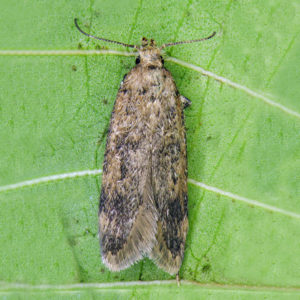The False Codling Moth (FCM) adult has patterned wings with a variation of colors (grey, brown, black and dark orange) and lays its eggs on the surface of the fruit. The FCM is nocturnal and is seldom seen in the orchard. The adult females lay their eggs (flat, translucent-white in color) on the surface of the fruit, once they hatch, the larvae burrow into the rind. The larvae are initially white with a black head, mature larvae are pinkish with a brown head.
Damage
When larvae feed minimally on the outside of the fruit, they create small “stings” on the surface of the fruit, When the larvae penetrate the fruit and tunnel to the core, feeding on the pulp and seeds they cause extensive interior breakdown of the fruit tissue leading to premature fruit drop. the exit hole (where mature larvae emerged) is often covered with frass. A brown discoloration can be observed at the point of penetration as well as an increase in the incidence of mold and disease. The point of entry becomes an open door to other pests and pathogens. Newly stung fruit are very difficult to identify in the packing house, so if fruit is stung close to harvest time it is possible that infested fruit will be packed into an export carton.
There are specific natural enemies and sustainable solutions for different species of moths.
For more information contact your local BioBee field agent.









